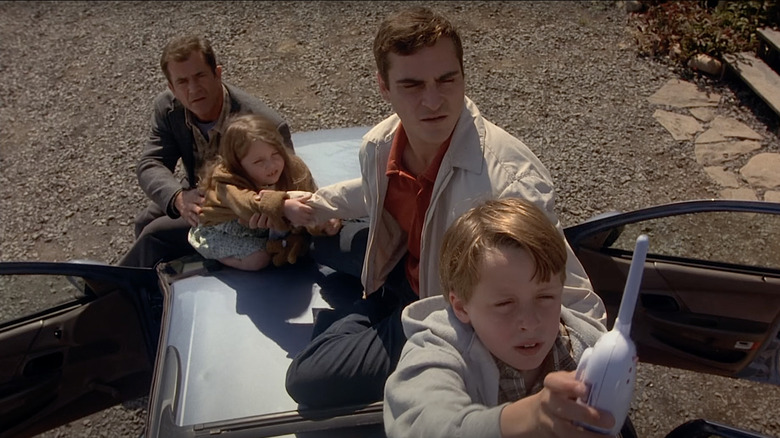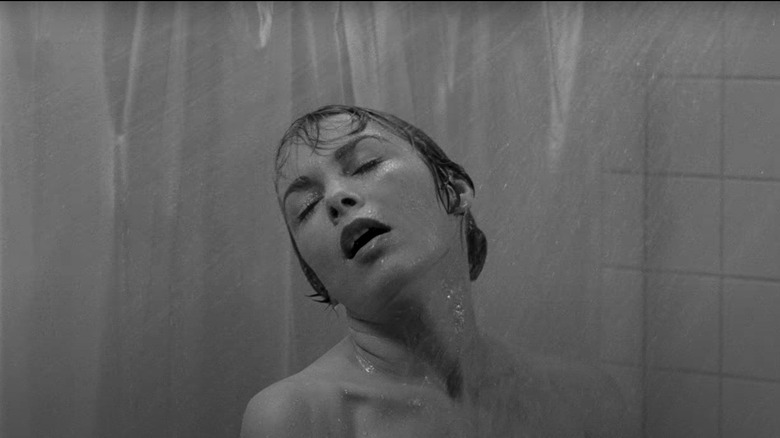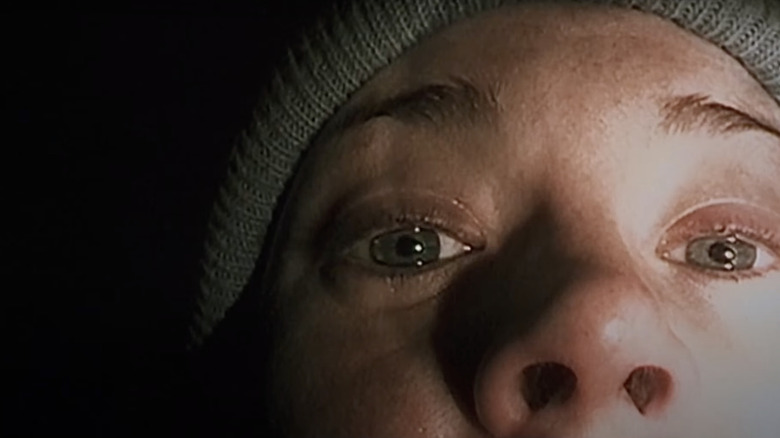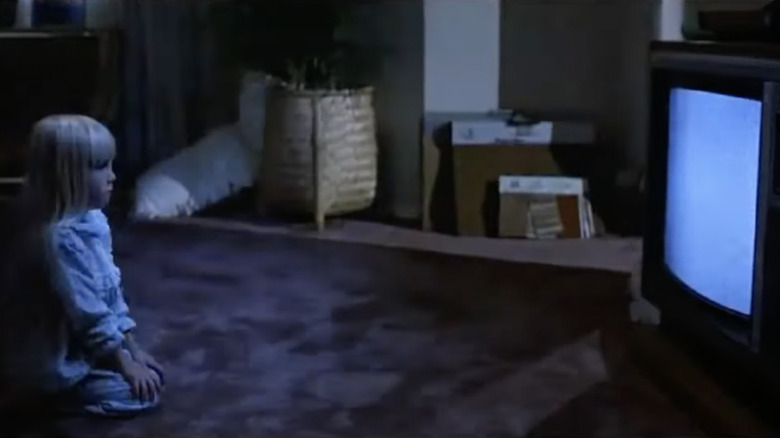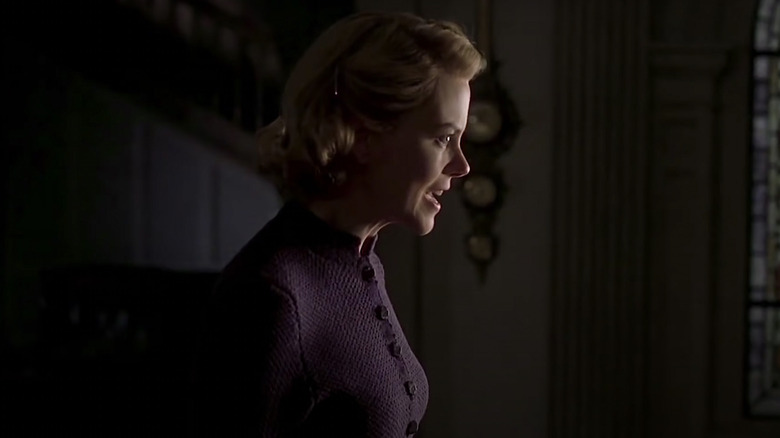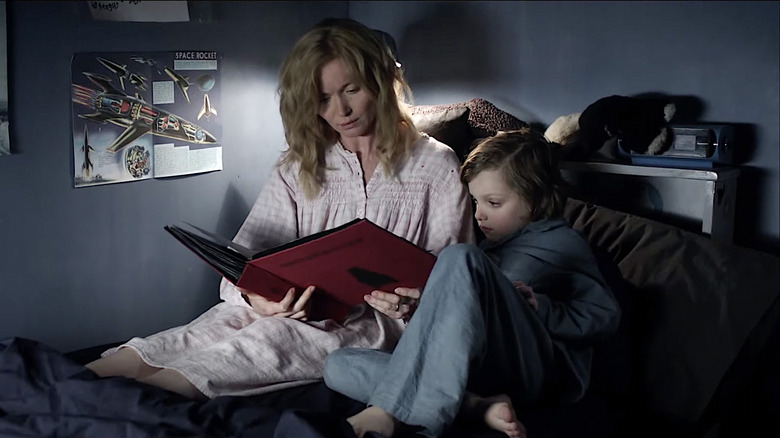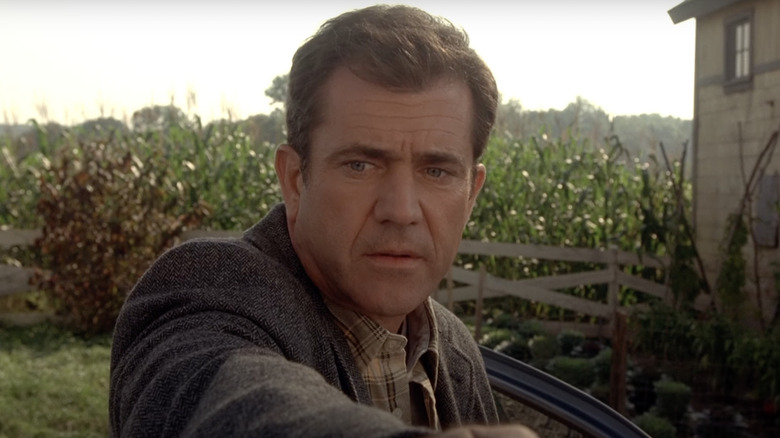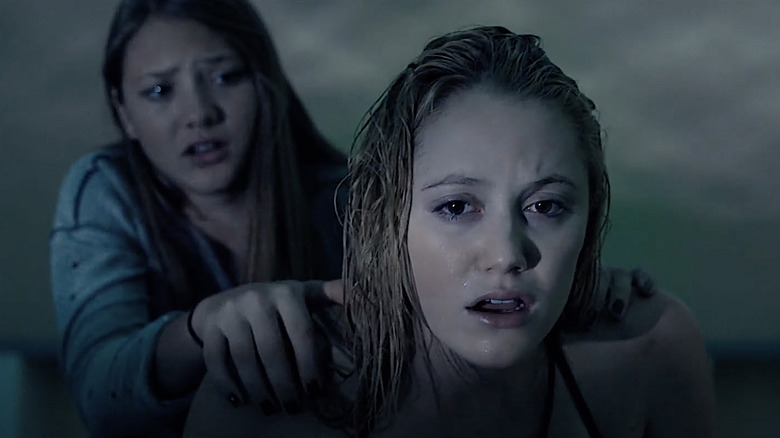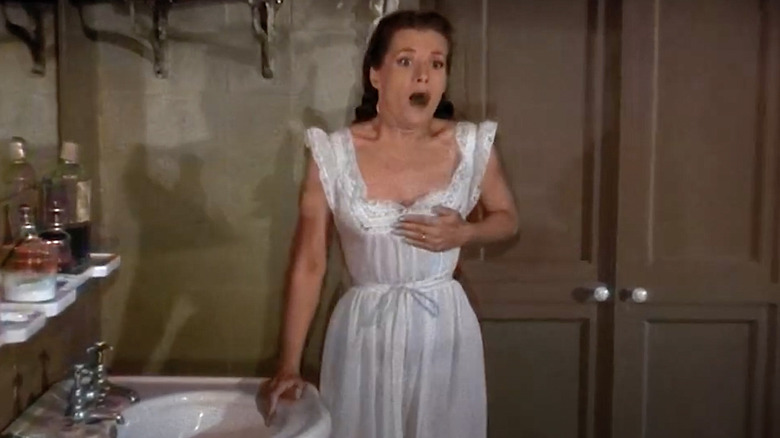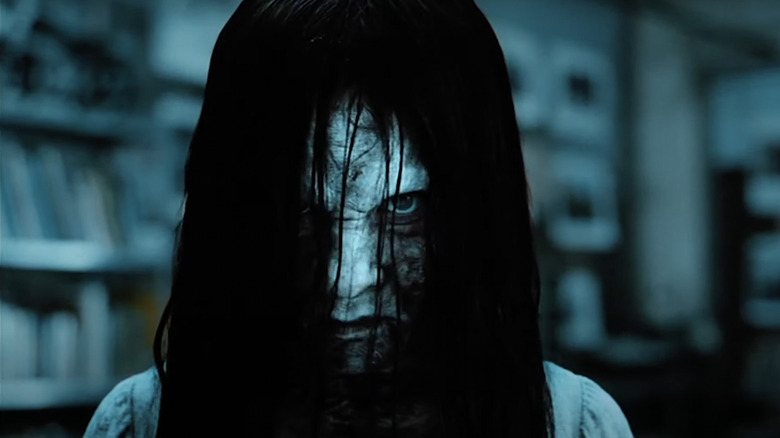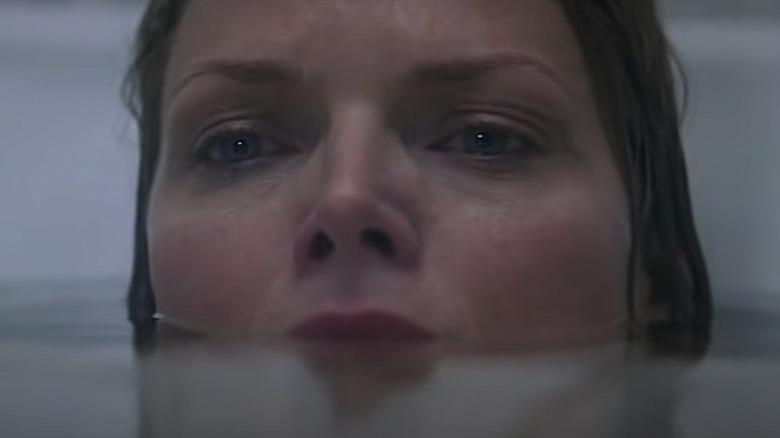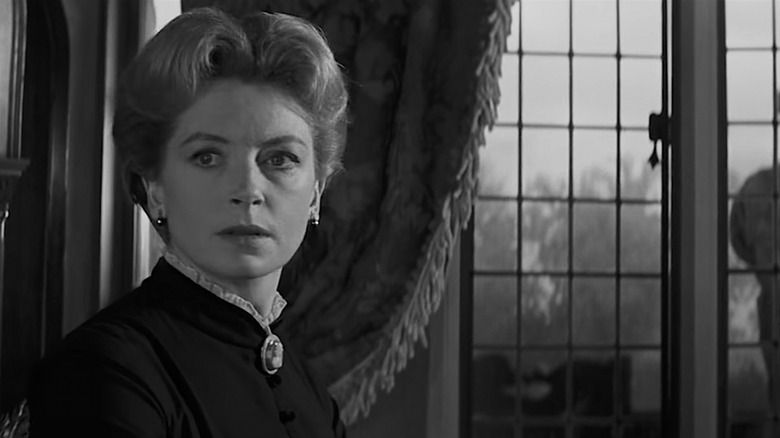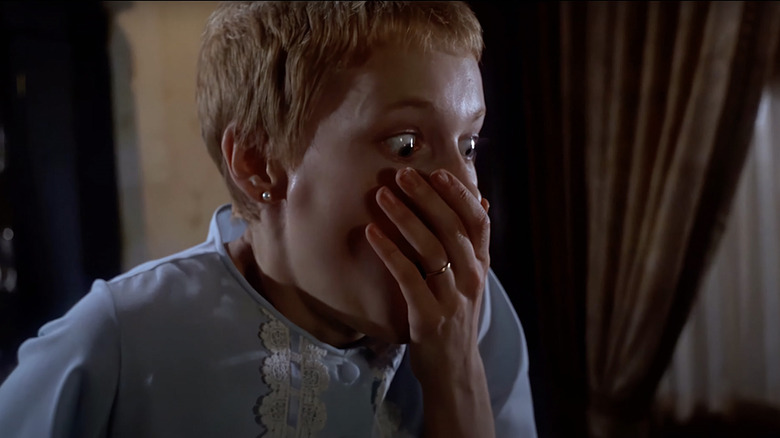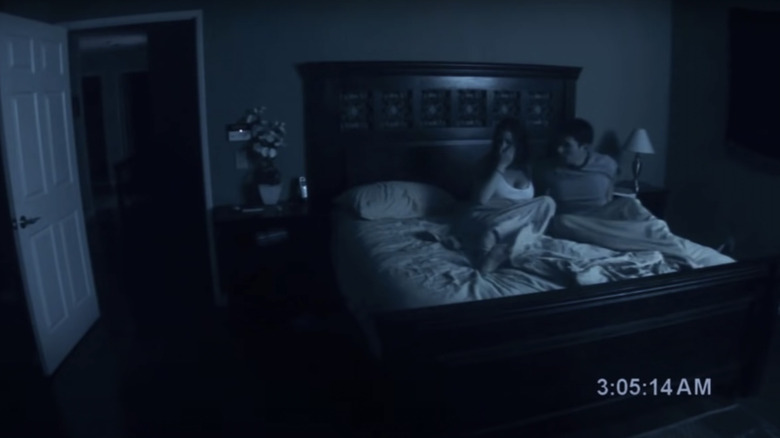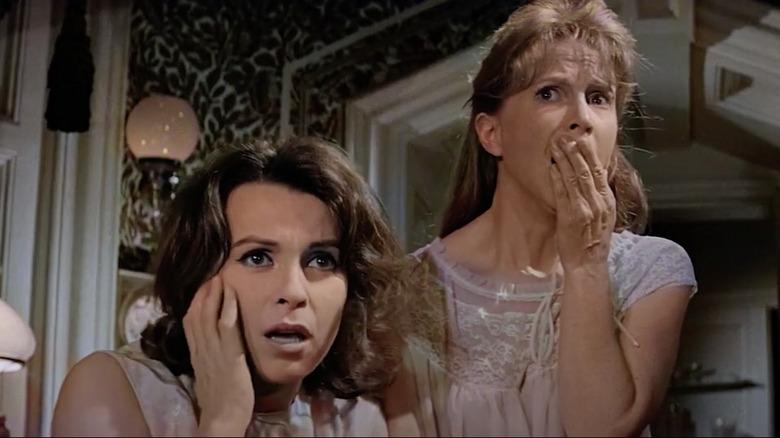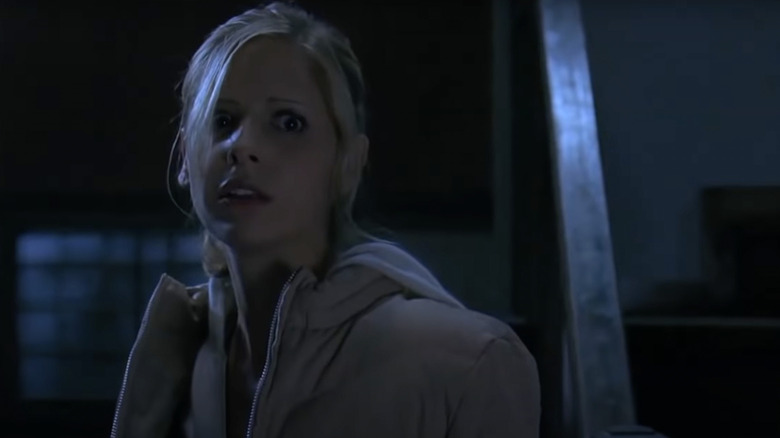The Best Horror Movies With Little To No Blood
We may receive a commission on purchases made from links.
Bloodshed in movies gets a bad rep by being lumped together as if it's all one kind of thing. Some films really earn their bloody moment of catharsis, as in Quentin Tarantino's movies where the violence is over the top, cartoonish even. There's another kind as seen in films like "Cabin In The Woods" where violence is like a comedic jump scare. The excessive nature of the gag is both the surprise and the payoff, as in the scene where a beautiful unicorn viciously gores a man to death. Then there's slasher movie bloodshed as seen in the "Friday The 13th" franchises where murders are well-staged, but also gruesome for gruesome's sake. The "Saw" franchise is the apotheosis of this mode of mayhem, purely exploitative and trying to test the limits of your gag reflex.
Bloodless horror movies, on the other hand, don't do any of this, so they add an extra ingredient to make up the difference: suspense. Flipping on these films is like buying low-fat ice cream, where you turn over the quart to find a glut of glucose added to fill the gap. If anxiety, curses, and spectral spooks hit your sweet tooth more than suffering and sadism, these horror movies with little to no blood are for you.
Psycho (1960)
"Psycho" shouldn't be cited as an early example of a trans story, as Norman Bates is something else entirely. As Hannibal Lector said of Buffalo Bill in "Silence of the Lambs" (a much bloodier but equally Freudian film), "Billy is not a real trans-sexual ... his pathology is a thousand times more savage and more terrifying." Norman Bates as played by the incredible Anthony Perkins has the most endless Oedipal complex you'll ever see. One part of his mind checks guests into the remote family motel, as the other watches them through holes in the walls. That's how he meets Marion Crane (Janet Leigh), on the run after stealing $40,000. Bates lashes out at this blond beauty because he can't have her. All he has is his mother, and that's all he will ever have.
Like "The Texas Chainsaw Massacre" and the "The Silence of the Lambs," "Psycho" was inspired by the real crimes of serial killer Ed Gein, who had a shrine to his own mother in the house of horrors where he lived alone. Those other two films latched on to the gruesome elements of Gein's crime, whereas "Psycho" isn't gory. Even that famous shower scene is mostly bloodless, all done by implication. Alfred Hitchcock was more interested in a killer's fractured mind. Maybe it's debatable if this film holds up so many decades since it genuinely shocked audiences, but its place in the horror canon is undisputed.
The Blair With Project (1999)
"The Blair Witch Project" wasn't the first "found" footage film. The genre goes back to at least 1980 with another, more grisly horror feature called "Cannibal Holocaust," which delivers everything that title promises. Shot on the cheap with home cameras, "Blair Witch" presages TikTok, Youtube culture, and everything digital video creation would become. "For us, video was about to become as good as film," director Eduardo Sanchez told The New York Times. "All of a sudden, you could edit on your computer."
"The Blair Witch Project" builds great suspense, and if you can stomach never having an objective point of view, it's genuinely scary without ever being gruesome. The story follows three college students making a doc about the eponymous witch. When they set out into the woods to find her and lose their way, they begin living the legend. This film had a meager $60,000 budget, but with good distribution and genius viral marketing it raked in nearly $250 million in theaters. The ad campaign famously made it seem like what had been captured was all real. It's not a strategy that would work today, as Sánchez himself admits, but it spawned a series of shaky-cam imitators trying to cash in on this incredible margin.
Poltergeist (1982)
Steven Spielberg certainly isn't the first name you think of on a list of horror filmmakers, but that's only if you don't realize both "Jaws" and his first TV feature "Duel" are horror films. Spielberg wrote the screenplay for "Poltergeist" but Tobe Hooper actually directs, though it is unmistakably a Spielberg film with its family-oriented PG rating. There's no blood or guts here (with the exception of one intense hallucination scene involving a mirror) and it starts out like so many suburban horror films on a tour of an idyllic California bedroom community with rows of manicured lawns and kids riding bicycles through side streets and culdesacs
This very 70s-looking suburban dream (but actually set in 1982) is shattered for the Freeling family when the clan's youngest daughter starts communing with spirits through the television set. This movie takes the old warning about getting too close to the TV to absurd lengths, and one wonders what Spielberg makes of kids on iPads scrolling through Youtube. Regardless, these seances soon turn sinister. When the youngest daughter goes missing, the family enlists the help of a creepy exorcist to return their world to normalcy.
The Others (2001)
This particular 2001 ghost story takes place in the genre's most reliable setting: a large English manor. Grace (Nicole Kidman) is a recent World War II widower and now lives a strange and isolated life with her two children. When the house's staff mysteriously take flight, three new servants arrive, ostensibly responding to her ad. They learn Grace's peculiar rules: the many interior doors need always be locked, and the curtains must always be drawn. The children, Grace explains, have a curious sunlight allergy. You should be overwhelmed with the suspicion that these rituals are hiding something sinister, but Kidman sells it.
"The Others" director Alejandro Amenábar was still in his twenties when he made this memorable movie. He was even younger when he wrote the similarly twisty "Vanilla Sky." The precocious filmmaker has a knack for hiding painful secrets in plain sight with lots of dreamy red herrings. He was showered with awards season recognition in 2002. Amenábar's biggest coup was the astounding $210 million global box office on a lean $17 million budget. That's a seismic smash for what is actually a very restrained film that takes place entirely in a dimly lit house.
The Babadook (2014)
The scary sights of "The Babadook" are so vivid and creepy that it's more like going to an actual haunted house exhibit. It's all very Slender Man as this movie really jumps out and grabs you. "The Babadook" is the audacious debut of Australian writer-director Jennifer Kent. What started as a crowd-funded indie went on to become a modest-sized hit given its meager budget, but more than that, has become a cult classic in streaming largely because of its incredible creature design.
Amelia (Essie Davis) is a grieving widow and mother to six-year-old Samuel (Noah Wiseman). She lost her husband tragically, and violently, on the drive to the hospital as she went into labor. When her son starts acting out and struggling at school he requests Amelia read him a very creepy pop-up book called "Mister Babadook." Samuel becomes convinced the title character is real. As strange things start happening Amelia blames her son and rips up the book. When the troublesome tome returns fully intact, she thinks they have a stalker, but something worse is afoot. Sleepless nights and visions soon follow as the walls of their home, and the Babadook, begin to close in.
Signs (2002)
M. Night Shyamalan's "Signs" is the last great film in what was possibly the greatest three-peat horror hot streak of all time. Coming off "The Sixth Sense" and "Unbreakable," the director was being hailed as a savior for the genre, the next Alfred Hitchcock even. He followed those two measured masterpieces with this remarkably restrained alien invasion film, which actually takes the form of an intensely suspenseful creature feature. The director's quiet confidence as his camera moves methodically and without too much sound or fury perfectly sets the scene for the story of a troubled small-town family. Former preacher-man Graham Hess (Mel Gibson) has lost his wife and his faith, so when he finds mysterious crop circles in his fields, he's no longer eager to call it a sign.
When the little green men do come, Graham, his baseball slugger brother (Joaquin Phoenix), and Graham's children (Rory Culkin, Abigail Breslin) all hunker down at home as the monsters from beyond inch closer. Shyamalan is more interested in tension and family dynamics than in sci-fi or gore. He has a remarkably tender touch as Gibson's former man of the cloth fights both his demons and to save his family. This might be one of the only horror movies that's also a tear-jerker.
It Follows (2015)
"It Follows" is a viciously delightful play on teenage hookup culture with an irresistible premise. When the high school kids in this tale have intercourse, they pass along a demon that stalks them relentlessly. The only way to shake it off, even temporarily, is to sleep with someone new and pass on the curse. It's not an exact metaphor for a sexually transmitted disease. Further intimacy is not a salve for any known pathogen (consult your doctor for details). What's clever about this curse is it turns the prospect of a casual hook-up into an even more morally fraught gambit. Suddenly sexual courtship is nothing but a devilish game of deception ... or has it always been?
There is a pool that fills with blood, and some other slightly unseemly sights, but it's the artful kind in keeping with the overall David Fincher-level aesthetic of this beautifully shot horror gem from writer-director David Robert Mitchell. He's gone a bit dark since but Mitchell is a serious talent, and if "It Follows" is his high water mark it stands as a brilliantly eery entry combining suspense with amusing social commentary.
Les Diaboliques (1955)
"Les Diaboliques" from 1955 is devastatingly diabolical and easily made my list of the best 95 thrillers of all time (and many other lists too). It's also a ghost story, sort of. Like any good thriller, the plot is complex, with the loathsome dean Michel Delassalle (Paul Meurisse) running a boarding school with his wife Christina (Véra Clouzot) while also having an affair with a teacher, Nicole (Simone Signoret). The French film's twisted ménage à trois goes bad because, perhaps unsurprisingly, both women despise him. They lure Michel to a meeting where they drug him and drown him in a tub.
They leave his body in a pool to make it seem like an accidental drowning, but Michel's body is gone when the water is drained. That's curious. Soon even stranger things start happening as the murdered man becomes an apparition. This is a psychological horror film, and given the country of origin, you ought to expect more than just your standard spook story. Director Henri-Georges Clouzot packs a lot of plot into an intriguing and taut 107 minutes. This black and white classic will whet your appetite for spooky twists, but not waste your time.
The Ring (2002)
Like a lot of great English language horror films, this one is a remake of an overseas original. The 1998 "Ringu" from Japan is phenomenal, but the 2002 version by Gore Verbinski of "Pirates of the Caribbean" fame is so good it terrified an entire generation, all without any gratuitous gore. Naomi Watts plays Rachel, a reporter investigating the strange death of her niece. Soon she's embroiled in what feels like an urban legend. There's a VHS tape going around that delivers a horrible death within seven days of watching it. It's the ultimate supernatural snuff film but Rachel's journalistic instincts tell her there's only one way to find out. Once she presses play, she gets a phone call foretelling her demise and suddenly she's on the most nightmarish deadline of her career.
"The Ring" is a ghost story with a nice procedural mystery plot and plenty of great suspense. What really sets the film apart though is the unsettling imagery that doesn't rely on being gruesome. Some images just trouble us on a primordial level and this film's creepy climax does exactly that. There are multiple sequels to this classic but it should be obvious why those don't really work. This is accursed knowledge, and really, you can only watch once.
What Lies Beneath (2000)
"What Lies Beneath" didn't get a great critical or audience reception yet is worth returning to every now and again. We don't get treated to two towering A-list movie stars playing opposite each other in a horror movie often, and that fact alone is reason enough to watch. Harrison Ford and Michelle Pfeiffer play husband and wife in this typically well-crafted and massively big-budget Robert Zemeckis film (he of "Forrest Gump" fame). Zemeckis' proficiency with effects comes in handy as the haunting begins. Ford's Professor Norman Spencer previously stepped out on Pfeiffer's Clare with one of his students, but Clare oddly doesn't remember. It's been repressed.
These new empty nesters have a lake house and an otherwise seemingly stable marriage ... that is until Clare begins hearing voices and seeing strange sights. Norman tries to console her, but as Clarie's visions escalate she soon believes the neighbors may have committed a murder and now the ghost means her harm. What really works with "What Lies Beneath" is the suspicion cast on Ford. He's Indiana Jones and Han Solo! He can't be the bad guy! Right? Ford previously lent his star status to add reasonable doubt to a twisty thriller plot in "Presumed Innocent," which is also great. "What Lies Beneath" didn't deserve to get so badly buried.
The Innocents (1961)
"The Innocents" is a genre-defining ghost story and as essential as it gets. Adapted from the excellent and still very readable psychological thriller novella "The Turn of the Screw" by Henry James, this film is blood-curdling but bloodless. It delivers its chills by slowly increasing the tension, hence the screw oh so slowly turned.
Miss Giddens (Deborah Kerr) is the new governess of a sprawling and of course very creepy gothic mansion. She now has two very troubled children in her care after the suspicious death of their previous live-in teacher. Young Flora and Miles are becoming incredibly erratic, and their ward and uncle (Michael Redgrave) is consistently absent. They seem to be carrying the weight of some awful secret. The live-in housekeeper Mrs. Grose (Megs Jenkins) is kindly but unhelpful, keeping her insights as airy as her feather duster. Miss Giddens is pushed so far that she soon believes these children may be possessed and you begin to wonder if she's seeing specters or just going insane.
Rosemary's baby (1968)
Young Rosemary (Mia Farrow) and her husband Guy (John Cassavettes) seem like an ordinary couple in love as they move into a creepy New York City apartment building. Rosemary gets pregnant and it seems like an answer to her prayers, but she becomes suspicious of her strange next neighbors Roman and Minnie (Sidney Blackmer, Ruth Gordon). Her distrust leads to isolation as she beings to suspect the couple, and even her husband, of a demonic plot against her. The compelling thing about "Rosemary's Baby" from 1969 is that pretty early we suspect she's right. So what starts as an exercise in suspense evolves into one of the best-staged exercises in gaslighting since the film that is largely responsible for this term, Ingrid Bergman's turn in 1944's "Gaslight".
Farrow comes undone much more viscerally than the stoic Bergman. Roman Polanski's films of the 1960s were experimental and raw, though there's no blood really. This is psychological horror where the terror comes as Rosemary's worst fears materialize inside her. There is a terrible acquiescence to the power of evil that is the dark heart of this film, used to great effect in Ari Aster's more brutal but similarly mesmerizing "Midsommar." Few things are more chilling than watching a victim slowly give in.
Paranormal Activity (2007)
"Paranormal Activity" is one of the more profitable movies of all time. This found-footage fright fest was shot on a shoestring $15,000 budget, but grossed nearly $200 million at the box office, according to The New York Times. Given that incredible return, it spawned a series of sequels, but none matched the bloodless glory of the 2009 original. When Katie and Micah move into their new starter home strange happenings inspire them to install a series of security cameras. Suddenly we get eyes on all the things going bump in the night, and this footage is the entire basis of the film. The dialogue is largely improvised and there wasn't even a screenplay, more like a loose idea of what would happen.
The auditions of eventual leads Katie Featherston and Micah Sloat with director Oren Peli give a good insight into this process. Both actors were amateurs and that fact really adds something to the realism. If you've ever ingested real police interrogation footage via "Dateline" or elsewhere, you know ordinary people under stress don't behave with the mannered charisma of Hollywood stars. "Paranormal Activity" might leave out the guts but not the chills, and its ordinary protagonists really sell the supernatural.
The Haunting (1963)
The original film version of "The Haunting" makes lots of lists of the best horror movies of all time, and given the year it was distributed (1963), you can be sure its thrills do not rely on the ick factor. There was a lackluster 1999 remake with Catherine Zeta-Jones, and more recently the very popular "The Haunting of Hill House" miniseries on Netflix, both based on the 1959 novel of the same name by Shirley Jackson. It's all the same story: The creepy gothic manor of Hill House is 90 years old and the tales of its spectral happenings are legion. The creepy Dr. John Markway is interested in the supernatural and wants to take a somewhat scientific approach to document it all. He enlists a small group to enjoy the worst Airbnb experience ever as he thinks the strangers will entice and provoke the spirits.
There is a colorized version with that slightly splotchy effect that happens when saturation is added in post. The original black and white suffices to show off the real star of this film: the eerie sets built by Elliot Scott who would go on to help create the world of "Indiana Jones." Haunted house movies are all mostly remakes of this classic movie.
The Grudge (2004)
Bloodless horror movies mostly come in two shapes: ghost stories and curses. "The Grudge" from 2004 is the latter. It's an American remake of the 2002 Japanese original "Ju On" but by the same director, Takashi Shimizu, whose entire filmography will haunt your nightscape. Despite the English language redux, the film is still set in Japan. The Williams family moves into a new home in Tokyo where a terrible Shakespearean-level tragedy has occurred. This has unleashed a curse that latches on to anyone who comes near. When the family's caretaker for their elderly mother vanishes, she is replaced by Karen, played by Sarah Michelle Gellar just coming off her run as "Buffy The Vampire Slayer."
Karen soon witnesses firsthand the terrifying force that inhabits this home, and now "The Grudge" has passed on to her too. Some critics liked Shimizu's Japanese version of this film a little better, and that's fair, though neither movie nor the numerous sequels have exactly been media darlings. "The Grudge" was a hit though given its modest budget, and, with its PG-13 rating, it's ghastly enough, without unleashing a flood of blood and guts.
